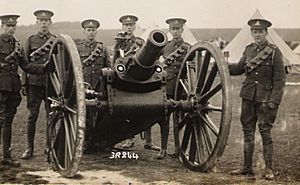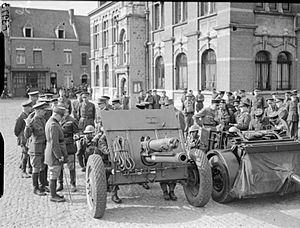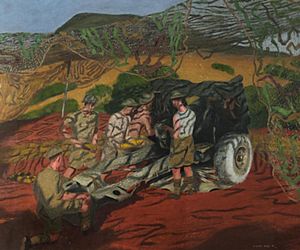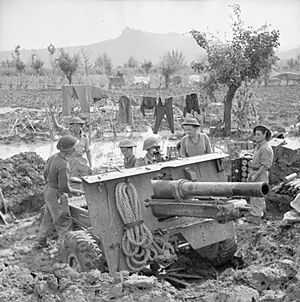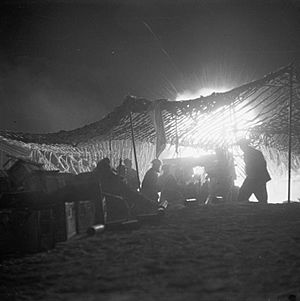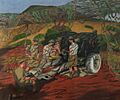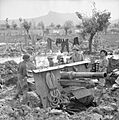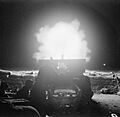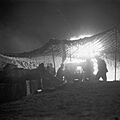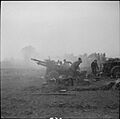1st Renfrew and Dumbarton Artillery Volunteers facts for kids
The 1st Renfrew and Dumbarton Artillery Volunteers was a group of part-time soldiers who were part of the British Army's Royal Artillery. They were formed in Scotland in 1860. These soldiers were like a local defense force, ready to help the main army when needed.
During the First World War, this unit, known as the 51st (Highland) Division, fought bravely at the Battle of the Somme. Later, it was split into different parts. In the Second World War, the regiment saw action in many important places, including the Battle of France, North Africa, Sicily, Italy, and North West Europe. They even helped during the Greek Civil War. After the wars, the unit continued as part of the Territorial Army until 1969.
Quick facts for kids 1st Renfrew & Dumbarton Artillery Volunteers3rd Highland Brigade, RFA 77th (Highland) Field Regiment, RA 277th (Argyll & Sutherland Highlanders) Field Regiment, RA |
|
|---|---|
| Active | 1860–1969 |
| Country | |
| Branch | |
| Type | Artillery Regiment |
| Role | Garrison artillery Position artillery Field artillery |
| Part of | 51st (Highland) Division |
| Garrison/HQ | Greenock |
| Engagements | Battle of the Somme Battle of France Battle of Alamein Tunisia Sicily Italy Normandy North West Europe Rhine Crossing |
Contents
- Volunteer Force: How the Unit Started
- Territorial Force: Modernizing the Army
- First World War: The Great War Begins
- Interwar Years: Rebuilding the Army
- Second World War: Global Conflict
- Postwar: Changes and Mergers
- Uniforms and Badges
- Commanding Officers: The Leaders
- Honorary Colonels: Special Supporters
- Images for kids
Volunteer Force: How the Unit Started
In 1859, many people in Britain worried about a possible invasion. This led to a lot of excitement for the Volunteer movement. People wanted to become part-time soldiers to help the regular British Army.
In 1860, several Artillery Volunteer Corps (AVCs) were formed in Renfrewshire and Dumbartonshire. These were groups of volunteers who trained with cannons. On August 22, 1863, six of these groups joined together to form the 1st Administrative Brigade, Renfrewshire Artillery Volunteers. Their main office was in Greenock.
- The 1st (Greenock) Renfrewshire AVC started on January 20, 1860.
- The 2nd (Greenock) Renfrewshire AVC also started on January 20, 1860, but later joined the 1st.
- The 3rd (Greenock) Renfrewshire AVC, also from January 20, 1860, also joined the 1st.
- The 1st (Helensburgh) Dumbartonshire AVC began on February 9, 1860.
- The 2nd (Rosneath) Dumbartonshire AVC started in March 1860 and later moved to Kilcreggan.
- The 3rd (Dumbarton) Dumbartonshire AVC was formed on December 24, 1860.
In May 1880, these volunteer groups were officially combined. They became the 1st Renfrew and Dumbarton Artillery Volunteers. Their headquarters remained in Greenock, and they had batteries (groups of cannons) in Greenock, Helensburgh, and Dumbarton.
Position Artillery: Moving Cannons Around
At first, the AVCs were meant to protect fixed places like forts. But some early units used "position batteries." These were cannons that could be moved, pulled by farm horses. The War Office didn't pay for these, so they stopped being used.
However, in 1888, the idea came back. Some volunteer batteries were set up to work with infantry (foot soldiers). In 1889, the 1st Renfrew & Dumbarton AV received 40-pounder Rifled Breech-Loading guns. These were powerful cannons that could fire shells that spun, making them more accurate. Two of the Greenock batteries used these guns.
Royal Garrison Artillery: A New Name
In 1882, all the AVCs became part of the Royal Artillery (RA). The 1st Renfrew & Dumbarton AV joined the Scottish Division. In 1899, the RA split into two main parts: field artillery (for battles on open ground) and garrison artillery (for defending fixed positions). The volunteer artillery units, including this one, became part of the Royal Garrison Artillery (RGA).
On January 1, 1902, the unit's name changed to the 1st Renfrew and Dumbarton Royal Garrison Artillery (Volunteers). Their main office and training areas were in Greenock. They practiced shooting their guns at Irvine and had a rifle range near Greenock. During the Second Boer War, 72 men from the unit volunteered to serve overseas, but only three were chosen.
Territorial Force: Modernizing the Army
In 1908, the British Army was reorganized under the Haldane Reforms. The old Volunteer units became part of the new Territorial Force (TF). The men from Dumbartonshire joined the Clyde Royal Garrison Artillery, while the Renfrewshire men joined the Royal Field Artillery (RFA).
They formed the III (or 3rd) Highland (Howitzer) Brigade, RFA, based in Greenock.
- 1st Renfrewshire (Howitzer) Battery
- 2nd Renfrewshire (Howitzer) Battery
- 3rd Highland (Howitzer) Ammunition Column
This unit was part of the TF's Highland Division. Each battery received four 5-inch howitzers, which were cannons that fired shells in a high arc.
First World War: The Great War Begins
Mobilisation: Getting Ready for War
On July 29, 1914, the Highland Division was warned that war was coming. On August 4, 1914, they received the order to get ready. Soldiers began gathering at their training halls the next day. By August 17, the division was fully assembled at Bedford.
When the war started, soldiers in the Territorial Force were asked if they would volunteer to serve overseas. Most men in the Highland Division said yes. Those who only wanted to serve at home formed reserve units. Soon, a second, "2nd Line" unit was created for every "1st Line" unit going overseas. These new units had "2/" in front of their names.
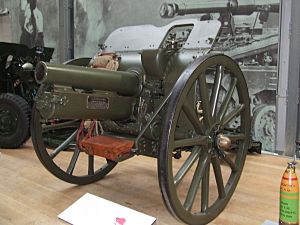
1/III Highland Brigade: Fighting on the Western Front
During the winter of 1914–15, the 1st Line units trained for war. Many soon left to join the British Expeditionary Force (BEF) on the Western Front in France. On May 3, 1915, the artillery units sailed from Southampton to Le Havre. By May 6, the Highland Division was in France and was officially named the 51st (Highland) Division.
Western Front: Early Battles
The new division quickly saw action at the Battle of Festubert (May 18–25). They also fought at the Battle of Givenchy (June 15–16). After these battles, the division moved to a quieter area to gain more experience. On January 11, 1916, their old 5-inch howitzers were replaced with modern 4.5-inch howitzers.
In May 1916, the RFA brigades were given numbers. The 1/III Highland Brigade became CCLVIII (or 258) Brigade. Its batteries were reorganized and equipped with 18-pounder guns, which were powerful field guns.
Somme: A Difficult Battle
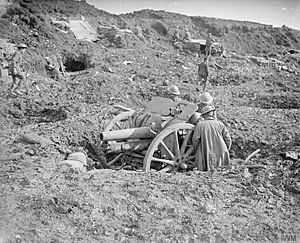
In July 1916, the 51st (Highland) Division joined the Somme Offensive. They were tasked with attacking High Wood. The bombardment began on July 22. German reports said the shelling was very accurate. The division attacked early on July 23 but suffered heavy losses and had to return to their starting point.
British gunners found it hard to support attacks on High Wood because they had to fire over a ridge. This meant shells sometimes landed too close to their own soldiers. Worn guns, bad ammunition, and incorrect information about where British troops were located were blamed for these "short-shooting" incidents. The division was pulled out of the front lines on August 7 for rest.
On August 23, the CCLVIII Brigade was broken up. Its batteries were sent to other brigades to make their 18-pounder batteries stronger. The soldiers from the III Highland Brigade continued to serve with their new units for the rest of the war.
2/III Highland Brigade: The Reserve Unit
The 2nd Line unit, 2/III Highland, was formed in Greenock by the end of 1914. This unit was part of the 2nd Highland Division (later called the 64th (2nd Highland) Division). However, they lacked equipment and had to send soldiers to the 1st Line units, which slowed their training.
In January 1916, the 2/III Highland Brigade received 4.5-inch howitzers and was numbered CCCXXIII (323) (H) Brigade. But it was immediately broken up, and its batteries joined other brigades. The 64th (Highland) Division remained a training unit until the war ended.
Interwar Years: Rebuilding the Army
The 3rd Highland (Howitzer) Brigade was reformed in the 51st (Highland) Division in 1920. When the TF became the Territorial Army (TA) in 1921, the brigade was renamed 77th (Highland) Brigade, RFA. It had its headquarters in Greenock and several field batteries in Greenock and Cathcart.
In 1924, the RFA became part of the Royal Artillery (RA). The word "Field" was added to the names of its brigades and batteries. By 1938, a lieutenant-colonel's command was called a "regiment" instead of a "brigade."
Second World War: Global Conflict
Mobilisation: Preparing for Another War
In 1938, the TA doubled in size. Existing units split to create duplicate units before the Second World War began. Field regiments changed from having four six-gun batteries to two batteries, each with three four-gun groups (called "troops").
From June 12, 1939, the 77th (Highland) Field Regiment was organized as: 77th (Highland) Field Regiment
- Regimental HQ (RHQ) at Greenock
- 305 (Renfrew) Field Battery at Greenock
- 306 (Renfrew) Field Battery at Greenock
A new unit, the 128th Field Regiment, was also formed:
- RHQ at Greenock
- 307 (Renfrew) Field Battery at Glasgow
- 308 (Renfrew) Field Battery at Greenock
77th (Highland) Field Regiment: Into Battle
When war broke out, the 77th (Highland) Field Regiment joined the 51st (Highland) Division. They still used their First World War-era 18-pounders and 4.5-inch howitzers, but now they were towed by modern gun tractors. In January 1940, the division moved to France to join the new British Expeditionary Force (BEF).
Battle of France: Retreat and Evacuation
The Battle of France began on May 10, 1940, when Germany invaded the Low Countries. The BEF moved into Belgium to defend along the River Dyle. However, German tanks broke through elsewhere, threatening the BEF's side. The BEF had to retreat.
By May 20, the BEF was on the Escaut river line. But on May 22, the Germans attacked strongly. The BEF was cut off and began to withdraw into a "pocket" around Dunkirk to be evacuated (Operation Dynamo). The 4th Division, which the 77th Regiment was part of, defended the northern part of the line. They then protected La Panne while the evacuation happened. On May 31, the soldiers had to destroy their equipment and march to Dunkirk to be picked up.
Home Defence: Rebuilding in Britain
Back in the UK, the regiment regrouped in Dorset. They joined the anti-invasion defenses on the South Coast. By September 1940, they were equipped with old French 75 mm guns. In December, they received modern 25-pounders. These regiments were reorganized into three 8-gun batteries. The 77th (H) Field Regiment formed a new battery, 455 Fd Battery, by February 1941.
In October 1942, the 4th Division was sent to North Africa to reinforce the Allied landings (Operation Torch).
North Africa: Fighting in Tunisia
The 4th Division landed in North Africa on March 23, 1943, joining the fight in Tunisia. They advanced against strong German resistance and were held up in the hills. The Germans counter-attacked at Medjez el Bab, but this attack was stopped.
The Allied offensive, Operation Vulcan, began on April 22. The 4th Division attacked on April 24. The fighting was tough, but they slowly pushed forward. The final assault, Operation Strike, began on May 5. The 4th Division attacked a ridge on May 6. The artillery fired a huge number of shells, breaking the enemy's resistance. By May 12, the Allies entered Tunis, and the Axis forces surrendered the next day.
After the Tunisian Campaign, the 4th Division stayed in North Africa until December 1943, then sailed to Egypt. In February 1944, they sailed to join the Italian Campaign.
Italy: Pushing Through Defenses
The 4th Division became active in Italy in April. Their role in the spring offensive was to cross the Gari river (Operation Diadem). A huge amount of ammunition was prepared for the attack on May 11. The field guns fired a "creeping barrage" that moved forward slowly, helping the infantry advance. The troops crossed the river but fell behind schedule. They held their position against counter-attacks with strong artillery support. By May 13, a bridge was open, and reinforcements crossed.
On May 14, the advance continued, outflanking the Monte Cassino position. After this, the 4th Division rested. They rejoined the fight after Rome was captured in June, pursuing the Germans to Lake Trasimeno. They fought hard to clear Vaiano and then supported other divisions attacking hills near Arezzo. The division continued towards Florence, clearing the Chianti mountains against tough German resistance. Florence was entered on August 4.
The next big attack was Operation Olive, aiming to break through the Gothic Line. The 4th Divisional artillery supported the initial attack on August 25. The division then moved forward, but breaking through the German defenses was slow and costly. A new phase began on September 12/13 against the Rimini Line, with massive artillery bombardments. The 4th Division continued the advance, crossing the Ausa river on September 17/18 with artillery support.
Operations in Italy then became bogged down in river crossings. The 4th Division's next major task was to capture a bridgehead over the Savio on October 19. The bridge was destroyed, so they had to make an assault crossing at Cesena the next day. They crossed the Ronco on October 31 but were stopped by Germans defending Forlì Airport. They attacked on November 7/8, with artillery focusing on the airfield buildings. The Germans retreated to the Montone. The division fought its way through a narrow area, using Air Observation Post aircraft to guide artillery fire onto German tanks. They finally broke through on November 12. Their last major operation in Italy was an attack on November 21 to cross the Cosina river.
Greece: Civil War Duties
The 4th Division was then pulled from the front line. They were supposed to go to the Middle East for rest, but were sent to Greece instead. A civil war (Dekemvriana) had broken out there after the Germans left. The artillery regiments were reorganized as infantry (foot soldiers) for security duties and guarding prisoners. Any artillery support needed was provided by Royal Navy warships.
By December 16, the division had set up defenses and began clearing the road from Faliron to Athens. Bitter fighting continued into the new year. The Greek People's Liberation Army (ELAS) began leaving Athens on December 27, and the British started an offensive on January 2, 1945. ELAS fully retreated from Athens on January 5.
The 77th (Highland) Field Regiment stayed in Greece until after the Second World War ended. It was officially put "on hold" on February 20, 1946.
128th (Highland) Field Regiment: Another Highland Unit
The 128th (Highland) Field Regiment was the "2nd Line" duplicate of the 77th Regiment, part of the 9th (Highland) Infantry Division. This division was later renamed the 51st (Highland) Division in August 1940, replacing the original one that had been captured. The 128th Field Regiment formed its third battery, 492 Fd Battery, on March 1, 1941. They were allowed to use the "Highland" subtitle from February 17, 1942.
After two more years of training in Scotland, the division sailed for Egypt in June 1942, arriving in August. The 128th (Highland) Fd Regiment was equipped with 24 powerful 25-pounder guns.
North Africa: El Alamein and Beyond
The 51st (Highland) Division's first major battle was the Second Battle of El Alamein. They moved into position at night, hiding their guns and ammunition during the day. For the first time, the British army had enough 25-pounders to focus their fire very effectively. The bombardment began at 9:40 PM on October 23 and lasted for hours. The 51st (H) Division faced strong resistance but made good progress.
On the second night, their guns supported another attack. On October 25/26, the 51st (H) Division continued to advance. The "break-out" phase, Operation Supercharge, began on November 1/2 with another powerful artillery barrage. By November 4, the 51st (H) Division broke through, and the Axis forces began to retreat.
The 51st (H) Division then pursued the enemy across North Africa. By February 25, 1943, they were facing the Mareth Line in Tunisia. The Axis forces attacked on March 6 (Battle of Medenine), but the British were ready and easily pushed them back. The 51st (H) Division had cleverly moved most of its artillery south, leaving only a few guns to trick the enemy into thinking the whole division was still in its old positions.
The Battle of the Mareth Line began on March 16/17. The main attack on March 20/21 involved another huge night barrage. However, progress was slow across the Wadi Zigzaou. The line held until other forces outflanked it from the south. The Axis defense collapsed on March 28, and the 51st (H) Division moved on to Gabès.
The next Axis defense line was along Wadi Akarit. The barrage for the 51st (H) Division's attack began at 4:15 AM on April 6. The division's attack went perfectly. Axis troops then counter-attacked, and the Highlanders fought hard to hold their gains. The pursuit continued the next day, through Sfax, and then the divisional artillery was active in the hills near Enfidaville. This lasted until Tunis fell and the campaign ended.
Sicily: Island Invasion
The 128th (H) Field Regiment then rested and trained for the Allied landings in Sicily (Operation Husky). The regiment landed on July 10, shortly after the first infantry. The division moved forward, capturing Palazzolo Acreide and Vizzini by July 14/15. Despite fierce fighting, they continued towards the Dittaino river.
On July 17, the division tried to cross the Dittaino and capture Paternò. They got a foothold but were stopped. On July 20/21, they attacked the main enemy defenses at Gerbini Airfield. Although they succeeded, strong counter-attacks drove them out the next morning. The 51st (H) Division then went on the defensive.
The 51st (H) Division's artillery helped with the artillery preparation for operations against Adrano (battles around Etna). These began on July 31. Paternò fell on August 4, and Biancavilla on August 6. By August 17, the Axis forces were leaving Sicily.
The 51st (H) Division did not take part in the rest of the Italian Campaign. Instead, they were chosen for the Allied invasion of Normandy (Operation Overlord). However, their guns did help with the massive bombardment covering the crossing of the Strait of Messina on September 3 (Operation Baytown). The division left for the UK on November 7 and arrived in Liverpool on November 26. They then trained for Overlord.
Normandy: D-Day and Beyond
The 51st (Highland) Division was in the first wave of follow-up forces for Overlord. They embarked on ships in London on June 2, 1944, and began landing on June 7 (D+1). Their guns immediately supported the Orne bridgehead. On June 23, the division expanded the bridgehead with a night attack. The guns remained silent before the attack for surprise, then stopped enemy attempts to retake the village.
On August 8, the 51st (H) Division led an attack towards Falaise (Operation Totalize), with a huge artillery barrage. The attack began before dawn and was successful. After another artillery preparation, other divisions passed through to continue the advance. The 51st (H) Division attacked on the left flank. By August 21, the Falaise Pocket was closed, and the division advanced east towards Lisieux.
The 51st (H) Division then moved to cross the Seine river for the assault on Le Havre (Operation Astonia). This was a major operation with massive artillery support and air attacks, which overwhelmed the enemy. A similar assault followed to take Boulogne (Operation Wellhit). The division then moved to the Antwerp area in late September.
Low Countries: Pushing Eastward
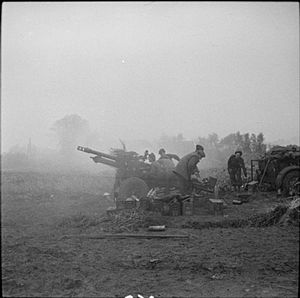
The division's next attack was west of 's-Hertogenbosch on October 23. With huge artillery support, the infantry took all their objectives. They continued advancing through Loon op Zand and across the Afwaterings Canal towards the Meuse river by early November. On November 14, the division crossed the Willems Canal near Weert with heavy artillery support.
The 51st (H) Division then moved to hold "The Island," a low-lying area between Nijmegen and Arnhem. In mid-December, they were pulled out for rest. They were then quickly moved south to respond to the German breakthrough in the Ardennes (Battle of the Bulge), fighting in winter conditions.
Rhineland: The Final Push
The 51st (H) Division was involved in the fighting in the Reichswald (Operation Veritable). It began on February 8 with a huge artillery preparation. The Highlanders attacked and reached their objectives that night. Over the next two days, the 128th Fd Regiment fired smoke and high-explosive shells to help the advance through the forest. The slow advance continued through Gennep, and German counter-attacks were stopped by defensive fire. The final phase for the 51st (H) Division began on February 18 against Goch, which was captured after tough fighting.
The division played a leading role in the Rhine crossing (Operation Plunder). Artillery observation teams from the regiment were among the first troops across the river on the night of March 23/24. The guns fired all night, very close to the river, often under enemy fire. The division fought its way into Rees, and the guns were brought across two days later. The division then continued through Isselburg and Anholt.
The division reached the Dortmund–Ems Canal on April 8. After a pause, they advanced quickly towards Bremen, facing delaying actions. They reached Delmenhorst on April 20 and closed in on Bremen. The German surrender at Lüneburg Heath ended the fighting on May 5.
The 128th (Highland) Field Regiment was officially put "on hold" on April 4, 1946.
Postwar: Changes and Mergers
When the TA was reformed in 1947, the 77th Fd Regiment became the 277th (Highland) Field Regiment in the 51st (Highland) Division. On March 10, 1955, it absorbed another unit, the 254th (West Highland) Anti-Tank Regiment.
Meanwhile, the 128th Field Regiment reformed as the 328th (Highland) Medium Regiment in 1947. In 1950, most of the regiment joined another unit, and one battery formed the 888th (Renfrewshire) Independent Locating Battery.
On May 1, 1961, the 277th Fd Regiment (mostly) and the 888 Battery merged with other units to form the 277th (Argyll and Sutherland Highlanders) Field Regiment. This new regiment had its headquarters from the 277th Regiment and batteries from the different merged units.
In 1967, the TA was reduced in size. The regiment merged with other units to form parts of the Lowland Regiment, RA. When the Lowland Regiment was further reduced in 1969, some personnel joined the 102 (Clyde) Field Squadron in the Royal Engineers.
In 1986, the 105 (Scottish) Air Defence Regiment was named the successor unit to the Lowland Regiment, RA.
Uniforms and Badges
The first uniforms of the Renfrewshire AVCs were blue jackets with scarlet (bright red) details. They had silver buttons with a special badge: the Prince of Wales's feathers and a crown above a gun, surrounded by a strap with "RENFREWSHIRE VOLUNTEER ARTILLERY." The 2nd Dumbarton AVC wore a blue uniform with scarlet facings and white belts. After they combined, the unit wore a standard RA helmet.
When the 277th Fd Regiment merged with the 402nd (Argyll & Sutherland Highlanders) Light Regiment, they adopted the Argyll & Sutherland Highlanders' Tam O'Shanter bonnet (a type of Scottish hat) and cap badge. They also wore a special regimental flash: a narrow red and white checkered strip with green ends.
Commanding Officers: The Leaders
The unit was led by many brave officers over the years, including:
- Lt-Col John Scott, from August 22, 1863
- Lt-Col William Anderson, from June 11, 1892
- Lt-Col Robert Duncan, from May 13, 1894
- Lt-Col Francis G. Gemmill, from May 18, 1898
- Lt-Col Charles C. Scott, from January 18, 1902
- Lt-Col P.C. Macfarlane, from May 17, 1913
- Lt-Col D. Paterson, from May 1, 1921
- Col H.C. Walker, from May 1, 1925
- Col G.W. Manuel, from May 1, 1930
- Lt-Col M.V. Service, from May 1, 1935
- Lt-Col W.H. Denholm, around 1939
Honorary Colonels: Special Supporters
These individuals served as Honorary Colonels, a special role of support for the unit:
- Col J. Reid, appointed June 17, 1905
- Col Charles C. Scott, a former Commanding Officer, appointed September 20, 1913
- Col P.C. Macfarlane, a former Commanding Officer, appointed June 18, 1921
- Col H.C. Walker, appointed July 8, 1931
Images for kids


